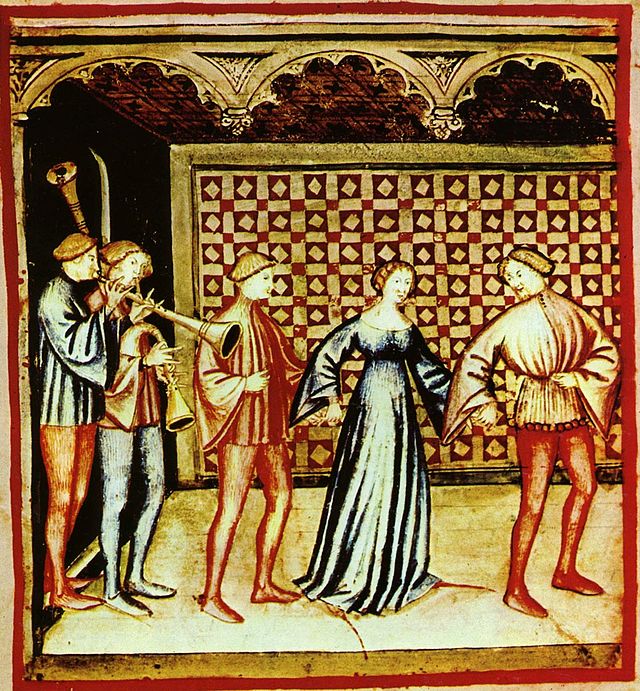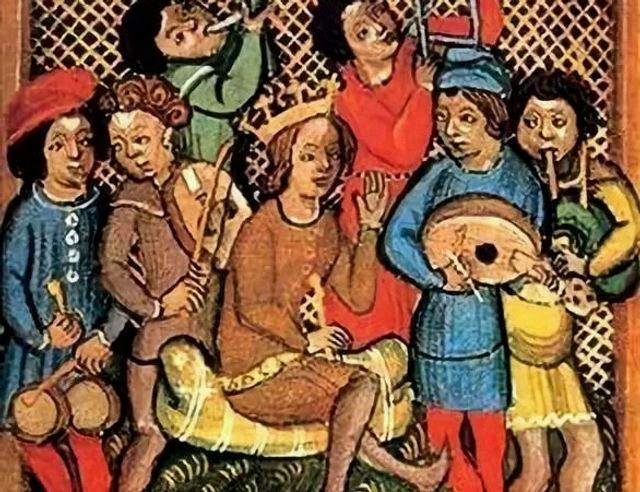Estampie is one of the oldest forms of instrumental music that has survived to this day. It is a medieval dance form that originated in Europe during the 12th century. The name “estampie” comes from the Old French word “estanpie,” which means to stamp or to make a loud noise.
The estampie was primarily danced by couples, with one man and one woman dancing together. However, it could also be danced in larger groups of couples. The dance was usualy performed at stately affairs such as royal weddings or banquets.
The musical structure of the estampie is derived from the sequence, which was a medieval genre of Latin hymn. Like the sequence, the estampie has a series of repeated melodic phrases, with phrase endings in the repetitions often varied. This gives the music a sense of progression and variation, while still maintaining a consistent theme.
The estampie is one of the earliest surviving examples of written instrumental music, with some manuscripts dating back to the 13th century. These manuscripts contain notations for instruments like the lute, harp, and vielle (a type of medieval fiddle). The music is often written in a tablature form, which indicates which strings and frets should be played on the instrument.
One of the most notable characteristics of the estampie is its rhythmic structure. It is often in a triple meter, with a strong emphasis on the first beat of each measure. This gives the music a lively and energetic feel, perfect for dancing.
Despite its age, the estampie has had a lasting impact on music throughout the centuries. It has influenced the development of other dance forms like the galliard and the pavane, and its rhythmic structure can still be heard in modern music genres like folk and world music.
The estampie is a fascinating example of medieval instrumental music and dance. Its rhythmic structure, melodic repetition, and historical significance make it a valuable part of music history.
Is Estampie Danceable?
The Estampie is a dance that was intended to be danced. It was a popular dance during the medieval period and was danced on vrious occasions, including stately affairs. The dance was typically performed by one man and one woman as a couple, with only one couple dancing at a time. However, larger groups of couples could also perform the dance together. The Estampie was a lively dance with a distinctive rhythm and tempo, and it required the dancers to move in a series of steps and turns. Although the dance has evolved over time, there are still some modern interpretations of the Estampie that are danced today. the Estampie is a dance that has stood the test of time and continues to be enjoyed by many people around the world.

Characteristics of Estampie
The estampie is a medieval musical form that is characterized by a sequence of repeated melodic phrases. These phrases are often indicated by the letters aa, bb, cc, and so on. The endings of these repetitions are frequently varied, creating a sense of development and interest within the piece. Estampies are typically instrumental music, which means that they are played without vocals. They are also among the earliest examples of written instrumental music that have survived to the present day. the estampie is a fascinating and important musical genre that demonstrates the creativity and innovation of medieval musicians.
What is Estampie?
Estampie refers to a type of musical composition that was popular in the late Middle Ages. It is a monophonic musical work that usually lacks text and consists of several repeated units that were likely meant to accompany a dance. The estampie is believed to have originated in the 13th century in France and spread throughout Europe. It was typically performed on a variety of instruments such as the lute, vielle, rebec, and hurdy-gurdy. The estampie was ofen performed at courtly events and was considered a sophisticated form of music. Despite its age, the estampie continues to be studied and performed by musicians and musicologists today.
The Musical Style of Monks
Monk music is commonly referred to as Gregorian chant. It is a form of sacred music that has its roots in the Roman Catholic Church, and it is named after Pope Gregory I, who was the Bishop of Rome during the 6th century. This style of music is typically performed by choirs consisting of men and boys, or by members of religious orders in teir chapels. Gregorian chant is characterized by its monophonic texture, which means that all the voices sing the same melody at the same time. It is also known for its use of Latin text, which is sung in a free rhythm that is based on the natural inflections of the language. Gregorian chant has been an important part of Western music for over a thousand years, and it continues to be performed and studied by musicians and scholars around the world.
What Is Estampie Music?
Estampie is a genre of medieval era dance music that originated in Europe during the 12th century. It is characterized by a fast tempo and a repetitive, rhythmic melody that is often played on instruments such as the lute, harp, or percussion. The estampie was typically performed in a group setting, with dancers moving in a circular or figure-eight pattern to the beat of the music. The genre was especially popular in France, where it was used in courtly dances and oher formal occasions. Despite its age, the estampie continues to be performed and studied by musicians and scholars today, offering a fascinating glimpse into the musical traditions of the past.

Source: medievaldanceonline.co.uk
Creation of Estampie
Estampie was created in 1985 by Sigrid Hausen (aka Syrah), Michael Popp and Ernst Schwindl. The German music group primarily plays medieval music, but also includes modern influences from world and minimalist music in their repertoire. With over three decades of experience, Estampie has become a renowned name in the world of medieval music. They have released several albums, performed at numerous festivals and concerts, and have garnered a loyal fan following. Estampie’s creation in 1985 marked the beginning of a journey that has led to the band’s success and recognition in the music industry.
Is the Kalenda Maya an Estampie?
Kalenda Maya is an estampie, which is a type of instrumental dance music that originated in the 13th and 14th centuries. It is considered to be the earliest known example of an estampie. The melody of Kalenda Maya was used by troubadour poet Raimbaut de Vaqueiras, who added lyrics to create the song that is still popular today, 800 years later. The estampie was a popular form of music during the medieval period, and was often played at courtly dances and other social events.
The Tempo of Estampie
The tempo of Estampie – Eastcheap, composed by Nicholas Britell, is 148 beats per minute (BPM). This means that the song has a moderate to fast pace, making it suitable for energetic and lively performances. However, it is worth noting that the tempo can also be adjusted by playing the song at half-time, which reduces the speed to 74 BPM, or double-time, which increases it to 296 BPM. The choice of tempo ultimately depends on the desired mood, style, and context of the performance. Nonetheless, the original tempo of 148 BPM is an essential characteristic of the song and contributes to its overal musical character and appeal.
Types of Organum
Organum is a style of early Western music that involves the addition of one or more voices to a plainchant melody. There are three main types of organum: pure organum, discant, and copula. Pure organum is used when the chant melody is syllabic, meaning that each syllable of text is matched with a single note. In this style, the added voice(s) move slowly and smoothly in parallel motion with the tenor (the chant melody), creating a simple, harmonious texture.
Discant, on the other hand, is used when the chant melody uses ligatures, which are groups of two or more notes sung on a single syllable. In this style, the added voice(s) move more quickly and independently of the tenor, creating a more complex and intricate texture. The added voice(s) may also use melismatic passages, were several notes are sung on a single syllable, to add further ornamentation and interest.
The final type of organum is copula, which is used when the chant melody has a long melisma, meaning that several notes are sung on a single syllable. In this style, the added voice(s) move in a more free and improvisatory manner, weaving in and out of the tenor melody and creating a fluid, expressive texture. Copula organum is often used to emphasize important moments in the chant, such as the end of a phrase or the climax of a melismatic passage.

Conclusion
The estampie was a popular medieval dance form that originated in the 12th century. It was typically performed by one man and one woman as a couple, with variations in the melody and rhythm. The dance had a series of repeated melodic phrases with varied endings, making it an enjoyable and challenging dance form for both performers and audiences. The estampie is also significant for being one of the earliest examples of written instrumental music. Despite its ancient origins, the estampie remains a fascinating and intriguing dance form that continues to captivate music enthusiasts and historians alike.
